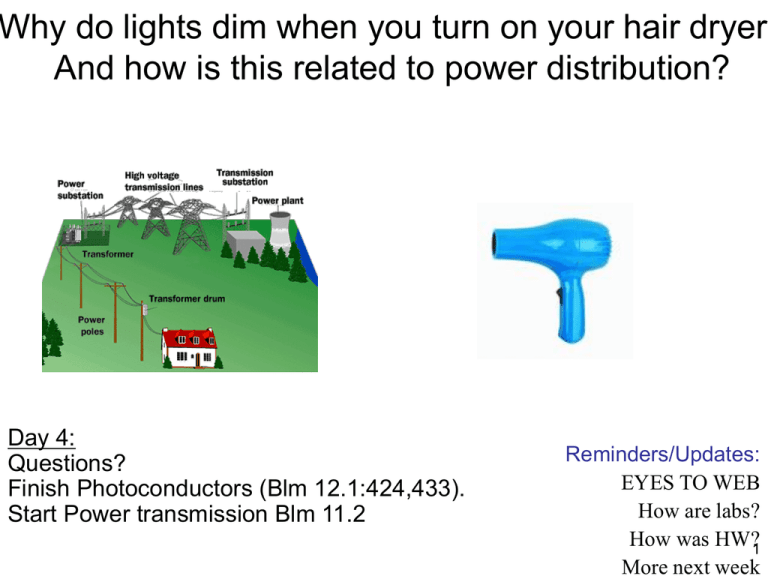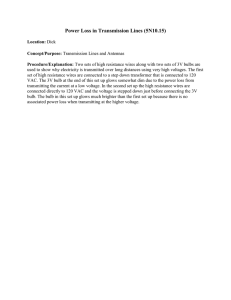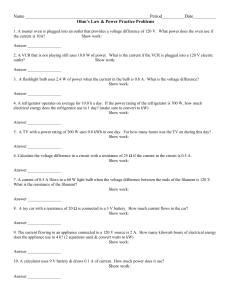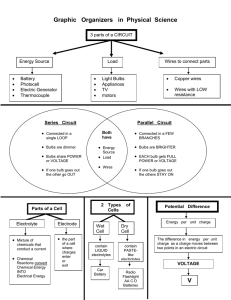Why do lights dim when you turn on your hair dryer? And how is this
advertisement

Why do lights dim when you turn on your hair dryer? And how is this related to power distribution? Day 4: Questions? Finish Photoconductors (Blm 12.1:424,433). Start Power transmission Blm 11.2 Reminders/Updates: EYES TO WEB How are labs? How was HW?1 More next week Wrapping up physics of copying machine. Making a Charge Image Photoconductor Corona wire metal velocity +++++ +++++ Light Document +++++ Charge image +++++ 2 Transferring Charge Image to Toner and Paper Roller and brush Release toner toner Light + +++++ Positive toner particle Charge image Charge Paper --- + + + ++ +++++ +++++ Black image + ++ + ++ Heat --+++++ Straightforward. All just good old physics of attraction between opposite charges, plus photoconductor physics. 3 Semi-conductor physics where light hits, R low, electrons flow away, then add ink, sticks only where charges. --------- -- ------------ - - Very special material- low R (“conducts”) only when light hits. “Photoconductor” V To understand, have to understand what determines resistance of a material. a. insulators (wood, ceramic, plastic)- very high resistance. b. conductors (metals)- very low resistance c. “semiconductors”- in the middle. Resistance depends on temp., light, cleanliness. 4 Looking at atomic structure of solids… energy bands many atoms Energy one atom levels get shifted and shared for all atoms and electrons. 5 In solid, billions of atoms, electrons, and levels!! levels get shifted and shared for all atoms and electrons. so many individual levels, just talk about bands of levels. 1 electron per level until run out of electrons. allowed levels but no electrons up there 3 2 1 orange- levels mostly full of electrons actually 1023 electrons and more levels!! 6 Microscopic look at material insulator- big jump to empties. conductor- empty levels very close empty gap- no levels empty full full electron like ball rolling on almost flat ground move easily electron like ball in pit. Can’t move without big boost. semiconductor-- half way in between. empty Little gap to empty levels full like shallow pit. 7 If apply voltage to make electron move, it must go into a. higher energy level, b. lower energy level, c. does not matter, these are the energy levels of electrons in atoms, no connection with motion. 3 2 1 moving a. higher- moving, more energy, really only slightly higher level. stationary If push on electrons (apply voltage to material) which ones will move? a. all of them in bands 1,2,3 b. none of them c. all of them in band 3 d. only the top one in band three d. only the top one in band 3. The others have no higher level they can move into, all filled with other electrons. After top one has gotten pushed up room to move next one below it. so maybe include billion or so really close ones. 8 Worth “seeing” in practice conductivity simulation http://phet.colorado.edu http://phet.colorado.edu/simulations/sims.php?sim=Conductivity RULE: for electrons to move (with a voltage applied) There must be an empty energy level immediately above where they are 9 Which band structure goes with which material? (be ready to give reasoning) empty full 1. Diamond 2. copper 3. germanium (poor conductor) a. 1=w, 2=x, 3=y b. 1=z, 2=w, 3=y c. 1=z, 2=y, 3=x d. 1=y, 2= w, 3=y. e. 1=w, 2=x, 3=y Energy 25 eV element w 0 x y z 10 Review of semiconductors. little gap empty full Little, but not tiny gap between filled and empty energy levels. Big enough to stop current (high R). Small enough so humans can find ways to boost electrons up. Concept behind all modern electronics! Use semiconductors to control electric currents. Which will decrease resistance of a semiconductor? add heat, light, shake, add dirt a. T T T T b T T F F c T T F T d F T F F e F T F T 11 Can also give electron kick of energy with light. Photo-conductor little gap empty full E = energy of photon = h x frequency (h) =h x c/(wavelength) = hc/ If green light has just enough energy to excite electron into empty level and allow it to move (conduct electricity) a. both blue and red light will also make it a conductor b. blue light will, red light will not c. neither blue nor red light will make it into a conductor blue light has shorter wavelength so higher energy than green, so it has more than enough energy. Red has longer wavelength than green so has less energy, not enough to boost electron to empty level where it can move/conduct. Photon energy hc/ needs to be bigger than energy of gap or will have no effect. 12 End of physics of copiers. Will return to more about semiconductors and use in electronics in couple of weeks. Final questions??? 13 On to power distribution system and the physics that makes it the way it is. Question to think about, and be ready to answer in a couple of classes. What is the relationship between the fact that lights sometimes dim with you turn on a hair dryer and that we have giant power transmission towers with cables hanging from them all over the country? 14 Power distribution and generation Why use AC power? 1. Energy loss in wires 2. Virtues of high voltage 3. Transformers and how they work ~1.5-2 days Power system and how transformers work in it. .5 days- power generation- same physics Big ideas: • Changing magnetic fields produce voltages and currents • Currents produce magnetic fields. 15 Distributing Power Across the Country • Long wires from power generating plants to homes (100’s of miles) • How much power will we lose in wires? (wasted power) • How can we minimize power lost in the wires? Explore what affects power loss. 16 Electron man! e 1) Lose energy by bumping into stuff in atoms. 2) Lose energy everywhere but in some parts more than others. 3) Voltage change across something represents amount of energy lost across it. lots of energy at start. Lotse of volts Wires: glide down pretty easily, just a few bumps. Lose a little bit of energy. e e -e e e e e e e e e e e e e e e e e e e e e e e e e e e e e Rtotal = Rlight + Rwires Usually small e e e e e e e + e e e e e e e e e e e e e e e e e Exhausted! energy used up getting through course. e e e e e e e Light Bulb… high resistance like trudging through three feet of mud! takes lots of energy to get through. 17 R (rottenness) How will brightness of bulb1 in case i compare to brightness of bulb1 in case ii (no #2)? a. brighter, b. dimmer, c. same b) dimmer, 2 bulbs have more resistance RTotal = R1+R2 so less current flows through them. P=IV=I2R 1 case i + 1.5 V case ii 1 2 1.5 V NOTE: Resistors (bulbs) in series (one after other) ADD, Resistors in parallel (different paths) act independently 18 Wall = 120 V AC Lights and power Wiring inside home “Power Source” (We can vary voltage output) 120 V Light 125 Watts Light 60 Watts Wiring inside home What is different between the 60 Watt bulb and the 125 Watt bulb? a. the voltage difference (amount of energy lost by each electron) across the bulb b. the number of electrons passing through the filament each second c. Choice a and the resistance of the filament d. Choice b and the resistance of the filament e. Choice a and Choice b and the resistance of the filament 19 No matter what the path, electrons lose all voltage (energy per electron) by the time they return to outlet. Vpath1 = Vpath2 = Vbattery (approx. for ideal R=0 wires) Appox! assume wires don’t waste energy lots of energy at start. (V) e e e ee e e e + Thinking like an electron. V1 = Vstart e e e e e e e e e e e e e e e e e e V2 = Vstart e e e e e e e - e e e e Path 1 e Path 2 e e + e e e e e e e e e e e e e e e e e e e e e e e e e e No energy left 20 Wall = 120 V AC Lights and power Wiring inside home “Power Source” (We can vary voltage output) Light 125 Watts Light 60 Watts What if hook 60 Watt and 125 Watt light bulbs in series, which will be brighter? (Share reasoning before experiment. ) a. 125 Watt bulb will be brighter b. 60 Watt bulb will be brighter 21 Thought process: Same current must pass through both bulbs. Can figure out current from total resistance: Rtotal = (R 60W bulb + R 120 W bulb + Rwires) + 60W 120W lots of energy at start. e e 60 Watt, Higher resistance e -e e e e e 120 Watt bulb Lower resistance e e e + e e e e e e e e e e e e e e e e e e e e e e e e e e 22 Home wiring Wall = 120 V AC Wiring inside home “Power Source” (We can vary voltage output) HEATER 120 V Wiring inside home 60 Watts \/\/\/\/\/ 1500 Watts Light Turn on Heater (close switch), observe light bulb. Light bulb dims. Why? Discuss with your group and come up with possible reasons. Share with class. 23 glide down easily, just a few bumps. Hardly any energy. e e e e e e e e e e e e e e e e e e e e e e e e e e e e e e e e e e lots of energy at start. e e e !?#%, bridge out, stuck. e energy used up getting through course. Vigor (V) e e e e e e e e e e e e e e e e e e e e e e e e e e e e exhausted! How much power and where is it going? Work through together. Plug voltage = 120 Volts Total resistance of wires = 0.1 ohms Resistance of lightbulb = 240 ohms Total resistance = Rwires + R bulbs = 240.1 ohms Current = Plug Voltage / Total R = 120 Volts / 240.1 ohms = 0.5 amps Voltage drop in wires = Current x resistance = 0.5 amps x 0.1 ohms = 0.05 Volts Power into wires = Current x voltage drop in wires = 0.5 amps x 0.05 volts = 0.025 Watts Power into bulb = current x voltage drop in bulb = 0.5 amps x 119.95 volts = 59.975 Watts 24 e’s piled up down both routes, so still divide up and go down both, just end up faster on bridge route What happens when bridge gets fixed so have another route? e e e e e e e e e e e e e e e e e e e e e e e e e e e e e e e e e e lots of energy at start. e e e deep mud! (bulb) energy used up getting through course. Vigor (V) e e e pretty easy e e e e e e e e e e e e e e e e e e e e e e e e e e e e e e e e e exhausted! What changes compared with bridge out (heater off) ? I. Current through wire is now larger II. Voltage drop across wire is now larger III. Voltage drop around whole circuit is now larger IV. Current through bulb is smaller V. Voltage drop across bulb is smaller a. I and III b. I and II c. I, II, V d. I, II, IV, V e. I, II, III, IV, V 25 What will make bulb even dimmer? I. Shorter wires II. Longer wires III. Adding another heater IV. Thinner wires V. Fatter wires a. I and V d. II, III, V. b. I, II, and III e. III only. c. II, III, and IV 26





